This page might contain affiliate links – this means I may earn a little coffee money if you purchase using these links. There is no extra cost to you.
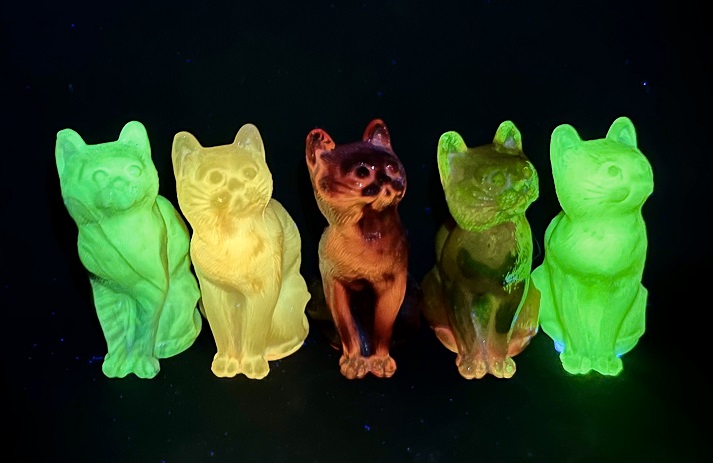
UV reactive glass – glass that glows under a “black light” – has become very popular in recent years, commanding premium prices in online sales and auctions. UV reactive glass cats are no exception – these “glowies” have acquired a fan club all their own!
Table of Contents:
- Glass Additives That Are UV Reactive
- FAQ
- UV Reactive Colors in Mosser Sitting Cats
- Mosser Sitting Cats – Colors that are NOT UV reactive
What makes them glow? Glass Additives 101
Glass that glows does so because of certain chemicals in the glass formula. The original intent was not to make it glow, but to either create or enhance the color, or the improve the color stability of the finished items.
The most common UV reactive additives found in glass:
Uranium oxide
Uranium oxide is depleted uranium. It gives the finished glass a slightly greenish tint in sunlight and glows bright green under a black light.
While some older uranium glass may emit a worrisome high level of radioactivity, contemporary glassware contains much less uranium and is generally considered safe. Uranium is no longer available for sale for glassmaking, which has driven up the demand and prices for existing uranium glass.
Some types of glass that contain uranium:
- Vaseline (clear yellow to greenish yellow)
- Custard Glass (opaque off-white)
- Burmese Glass (Custard glass shading to another color, like blue or pink.)
There’s no mistaking the bright green glow of uranium.
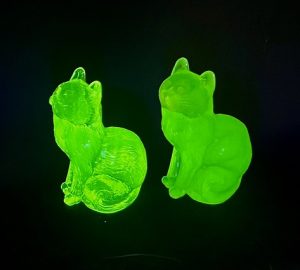
Manganese
Manganese is used to make purple glass. Smaller quantities are added to other colors (including crystal) to keep it from changing color with exposure to sunlight. It usually glows a softer green than uranium and is most noticeable with uv lighting at 365nm, although glass with a high manganese content will glow at 395nm. Most commonly found in amethyst and aqua glass, and some crystal. Pictured below: Amethyst satin and crystal.
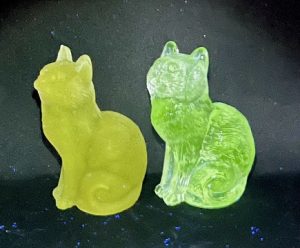
Cadmium (Cadmium Sulfide)
Found in yellow, red and orange glass. By itself, it adds yellow color and glows bright yellow or slightly orange-ish yellow.
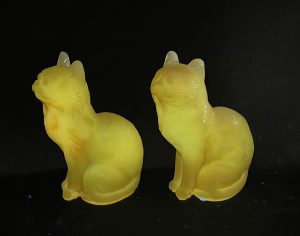
Selenium
Found in red and orange glass. By itself, it glows pink or red.
Cadmium and selenium are often used together for various shades of red and orange glass, resulting in glass that glows orange.
This Mosser sitting cat in Harvest has a little of everything!
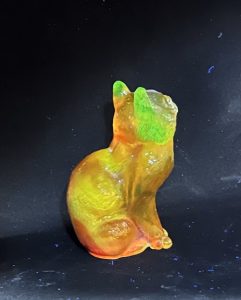
Lead – Glass with a high lead content glows blue. (Mosser did not make leaded glass.)
Boron Nitrate – Found in mould release sprays – makes it easier to remove glass from the mould. When used, it can react with some glasses (red in particular) and will fluoresce a unique shade of yellow-green on the surface of the glass. It is most commonly used on red glass, like this tomato colored Mosser cat:
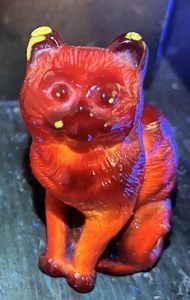
The color of the glass itself can affect the apparent color of the glass under UV light. For example, amethyst glass, which contains manganese, looks olive green under a black light, whereas crystal (clear) glass with manganese is a more neutral green tone.
Frequently Asked Questions
Is UV reactive glass safe?
While some of the older uranium glass (early 20th century) can be pretty spicy, with as much as 25% uranium, postwar uranium glass, made from depleted uranium, emits relatively benign alpha radiation and doesn’t emit enough of it to be harmful. The amount is within the range of normal background radiation.
Eating or drinking out of UV reactive glass is another story. Chips, cracks, overall wear and acidic foods or beverages served in uranium glass may allow for the consumption of small amounts of uranium. My grandma’s uranium glass juicer is a beautiful display piece, but I won’t be using it to make grapefruit juice. Just sayin’!
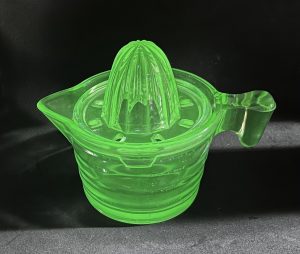
Cadmium is lovely to look at but definitely toxic – avoid eating, drinking or storing food in cadmium-containing glassware.
Selenium and manganese by themselves are probably harmless.
I have glass in a color which isn’t supposed to glow but it does (or vice versa). Is that a mistake on the list?
As I emphasize often on this site, glass making by hand is not an exact science. Any number of things can happen that affect one batch or even individual pieces of glass from one batch that cause them to be atypically UV-reactive, leftover glass in the tank being a common reason.
Should I buy a Geiger Counter for my uranium glass collection?
Serious uranium glass collectors distinguish between high manganese content glass and uranium glass with a geiger counter – uranium is radioactive, manganese is not. If this matters to you and you’re planning to invest in a geiger counter, you should know that uranium emits mainly alpha radiation – a range which is not detected by the cheaper ones. You need to decide if you want to go with an inexpensive one that is hit-or-miss, or splurge on a more expensive model with alpha ray detection. The GMC brand seems to be popular with the uranium glass crowd. Their lower-end 320+ or 320S are reasonably affordable. The GMC 600+, which does detect alpha rays, is pricey but not as bad as some competing brands.
UV Reactivity in Mosser Sitting Cats
UV color(s) and color names of known Mosser cats that glow. Unless noted otherwise, variations of these colors (satin, iridized, opalescent, slag) react the same way.
Sometimes you may come across a color on the non-uv list that glows a little or vice-versa. These are the exception, resulting from some anomaly in the process, and not noted here.
Bright Green (Uranium)
- Vaseline and variations (vaseline opal, vaseline satin)
- Slags with a vaseline base color (Tiger eye, Moonglo…)
- Custard glass and variations (custard, custard satin, green banana, brown banana, French vanilla)
- Slags with a custard base color (cameo bronze)
- Slags with custard glass slag (custard grape, Kashmir green)
- Sea Breeze
- Twilight
- Autumn (slag) may contain some uranium besides the cadmium
- Pearl
- Dark amber (name?)
Red and orange (cadmium / selenium)
- Red, calico, autumn, flame
- Black magic (glows deep red)
- Rubina
- Pumpkin, candy corn
- Wine
- Black cherry
- Blazer / Harvest
- Fiesta
- Clay
- Red slag (red calico)
- Persimmon
- Strawberry, Strawberry slag
- Tomato
- Marigold
Bright Yellow (Cadmium)
- Golden opalene
- Buttercup
Pale or Dull Green (Manganese)
- Amethyst and variations (amethyst satin, amethyst iridized)
- Jasmine and jasmine satin
- Heirloom pink
- Aqua and variations (aqua opal, aqua satin, aqua iridized)
- Plum (sugar plum)
- Some crystal
- Apple green
- Blue
- Violet or Lavender Ice
Colors that do NOT glow:
- Milk and variations
- Teal and variations
- Smoke n blue
- Gray and gray satin
- Cranberry, pink, rose
- Cobalt, cobalt satin, cobalt iridized, cobalt slag
- Taffy, chocolate (both), black
- Purple swirl
- Purple carnival
- Butterscotch slag
- Mandarin milk slag
- Turquoise
- Light yellow
- Wind frost (all colors)
- Green milk, green and milk slag, wintergreen
- Cobalt milk slag, MAC
- Peachblo
- Ritz blue
- Royal luster, Opal luster
- Blue milk
- Smoke
- Lime
- Black amethyst
- Hunter green, emerald green
- Willow blue
- Periwinkle
- Green opal
- Alexandrite
- Irish mist
- Dark green slag
- Milky blue
- Cloud 9
- Amber, Light amber, Honey
- Peppermint